Is Nordic walking for seniors the ideal exercise?
This guide will provide you with all the information you need to know about nordic walking for seniors. We’ve got you covered from its origins to the health benefits and practical tips.
What is nordic walking?
Nordic walking originated in Finland and has gained popularity worldwide as a low-impact, whole-body exercise. It involves walking with specially designed poles that engage the upper body muscles, providing a more comprehensive workout than regular walking.
Think of it as walking with a purposeful stride, harmonizing your arms, core, and legs.
The benefits of nordic walking for seniors
Nordic walking offers numerous benefits for seniors, making it an ideal exercise choice.
Some of the key benefits include:
Improved cardiovascular health
Nordic walking increases heart rate and promotes better blood circulation essential for maintaining a healthy cardiovascular system.
Enhanced balance and coordination
The use of poles helps seniors improve their balance and stability, reducing the risk of falls and injuries.
Strengthened muscles and bones
Nordic walking provides resistance and weight-bearing exercise, helping to strengthen muscles and bones, thereby reducing the risk of osteoporosis and age-related muscle loss.
Low impact on joints
Unlike running or jogging, it puts minimal stress on the joints, making it suitable for seniors with joint pain or arthritis.
Weight management
Regular nordic walking can help seniors maintain a healthy weight by burning calories and boosting metabolism.
Improved mental well-being
Engaging in outdoor activities and connecting with nature through nordic walking can positively impact seniors’ mental health, reducing stress and improving well-being.
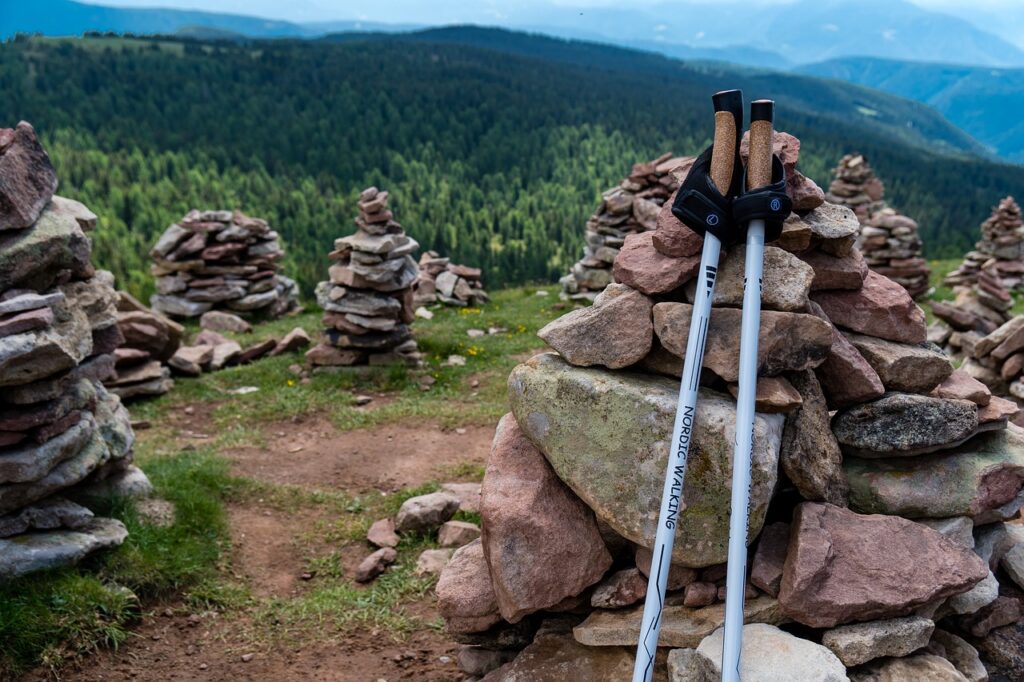
Getting started: equipment & technique
To get started with Nordic Walking, you’ll need the right equipment and proper technique:
Nordic walking poles
These are designed specifically for nordic walking, with adjustable lengths and wrist straps for better control and support.
Comfortable walking shoes
Choose shoes that provide good arch support and cushioning to ensure a comfortable walking experience.
Proper technique
Hold the poles with a relaxed grip, allowing your arms to swing naturally. Take longer strides, engaging your core and pushing off the poles with each step.
Warming up & stretching
Before starting your nordic walking session, warm up and stretch to prepare your muscles and prevent injuries.
Marching in place
Lift your knees high while swinging your arms.
Shoulder rolls
Roll your shoulders backward and forward to loosen up.
Leg swings
Stand near support and swing each leg forward and backward, gently increasing the range of motion.
Calf raises
Stand with your feet shoulder-width apart and rise onto your toes, then lower back down.
Remember to stretch your calves, hamstrings, quadriceps, and shoulders after the warm-up exercises.
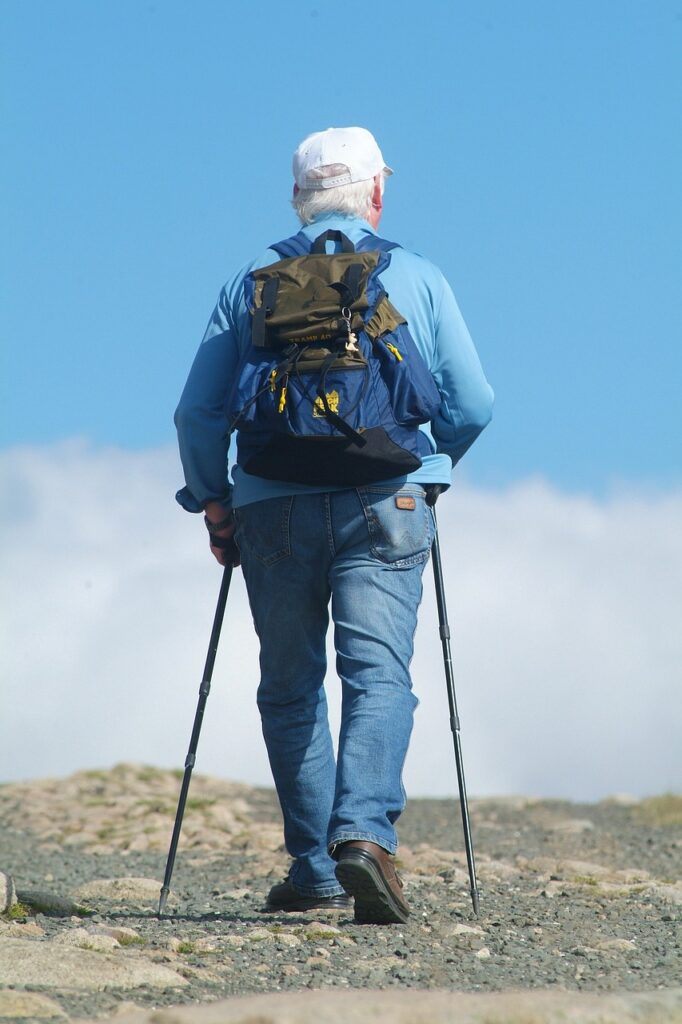
Nordic walking routes for seniors
One of the great things about nordic walking is that you can do it almost anywhere.
Some popular routes for seniors are:
Local parks
Many parks have paved trails or walking paths with scenic views, making them ideal for nordic walking.
Beaches
Walking on sand adds an extra challenge and engages your muscles.
Urban areas
Explore your neighborhood or city streets, enjoying the sights and sounds of your surroundings.
Nature reserves
Discover nature trails that offer a peaceful and serene environment for nordic walking.
Choose the routes suitable for your fitness level and consider walking with a friend or joining a nordic walking group for added safety and companionship.
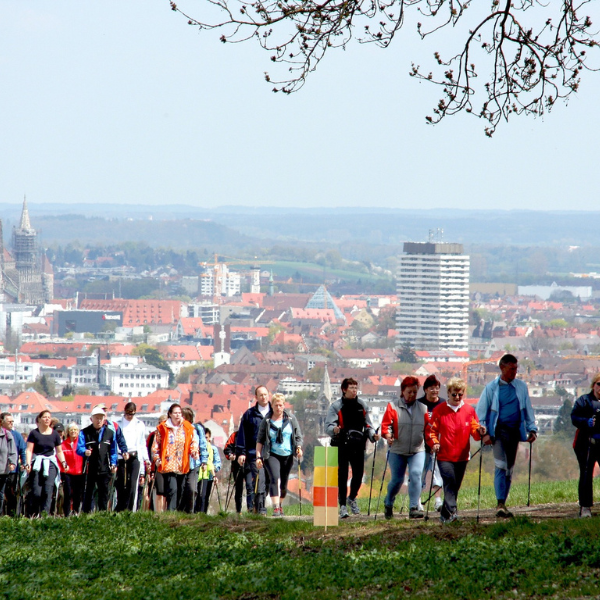
Incorporating nordic walking into your daily routine
Making nordic walking a part of your daily routine is a great way to stay consistent and reap the benefits.
Follow these tips to incorporate nordic walking into your schedule:
Start with shorter walks
Begin with shorter walks of 10-15 minutes and gradually increase the duration as your fitness improves.
Set goals
Challenge yourself by setting goals, such as increasing your distance or completing a certain number of daily steps.
Find a walking buddy
Walking with a friend or family member can make nordic walking more enjoyable and help you stay motivated.
Schedule your walks
Treat your nordic walking sessions as appointments and block off dedicated time for them in your calendar.
Mix it up
Vary your routes to keep things interesting. Exploring different environments can provide new experiences and keep you engaged.
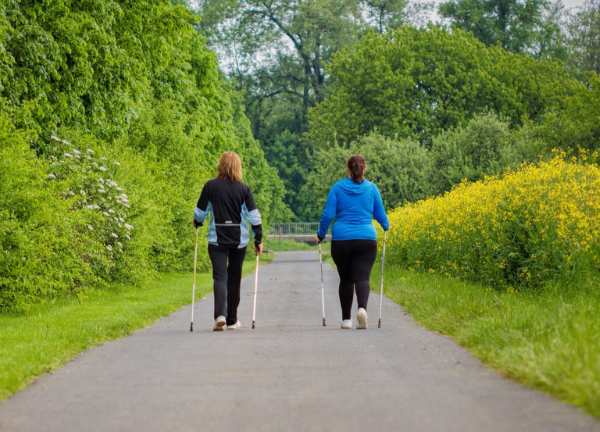
Improving balance & coordination
Nordic Walking is an excellent way to improve balance and coordination, reducing the risk of falls.
Focus on the following:
Proper posture
Maintain an upright posture with your head aligned with your spine. Engage your core muscles and avoid leaning forward or backward.
Arm swing
Allow your arms to swing naturally, synchronizing with your stride. This rhythmic motion helps improve coordination.
Focus on technique
Concentrate on proper technique, ensuring you push off the poles with each step and engage your whole body.
Nordic walking for cardiovascular health
Nordic walking is an excellent form of exercise for improving cardiovascular health.
Increased heart rate
Nordic walking raises your heart rate, providing a cardiovascular workout that strengthens your heart muscle.
Lower blood pressure
Regular nordic walking helps reduce blood pressure.
Improved circulation
The arm movements and engagement of upper body muscles promote blood flow, enhancing circulation throughout your body.
To maximize the cardiovascular benefits, maintain a brisk pace during your Nordic Walking sessions and aim for at least 30 minutes of continuous walking.
Strengthening muscles and bones
Nordic Walking also helps strengthen muscles and bones. Here’s how it works:
Engaging the upper body
Poles engage the muscles in your arms, shoulders, and back, providing resistance and strengthening these muscle groups.
Weight-bearing exercise
It’s a weight-bearing exercise that stresses your bones, promoting bone density and reducing the risk of osteoporosis.
Full-body workout
Nordic walking provides a comprehensive workout that targets multiple muscle groups simultaneously.
To maximize the muscle and bone-strengthening benefits, focus on maintaining proper technique and gradually increasing the intensity and duration of your walks.

Socializing and connecting with others
Nordic Walking benefits your physical health and allows socializing and connecting with others.
Consider these options:
Join a nordic walking group
Many communities have Nordic Walking groups or clubs where you can meet like-minded individuals and enjoy walks together.
Participate in events
Look for nordic walking events in your area, such as charity walks or group hikes. These events are a great way to connect with other seniors who share the same interest.
Walk with friends and family
Invite your friends, family members, or neighbors to join you for nordic walking. It’s a wonderful way to spend quality time together while staying active.
Safety tips for nordic walking
Consider the following safety tips:
Use proper equipment
Ensure you have the right nordic walking poles suitable for your height and walking style. Check that the wrist straps are secure and adjust the pole length accordingly.
Choose suitable routes
Select routes that are well-maintained, free of obstacles, and have good lighting if walking during low-light hours.
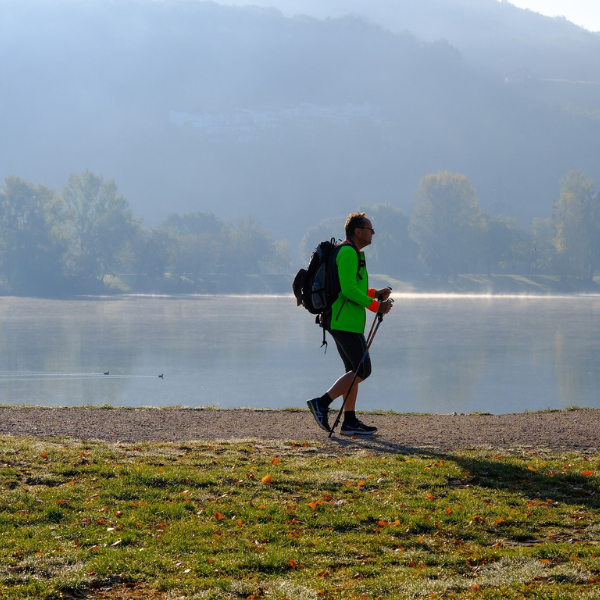
Dress appropriately
Wear comfortable clothing and suitable footwear for walking. Consider the weather conditions and dress in layers to adjust for temperature changes.
Stay hydrated
Bring a water bottle, especially during longer walks or hot weather. Stay hydrated to maintain your energy levels and prevent dehydration.
Listen to your body
Pay attention to any discomfort or pain during your walks. If you experience any unusual symptoms, such as chest pain or shortness of breath, stop walking and seek medical attention if necessary.
Common mistakes to avoid
While nordic walking is straightforward, beginners may make some common mistakes.
Watch out for:
Gripping the poles too tightly
Maintain a relaxed grip on the poles, allowing your hands and wrists to move naturally with each stride.
Leaning too far forward or backward
Maintain an upright posture and avoid leaning excessively in any direction.
Dragging the poles behind
Plant the poles firmly in front of you and push off with each step.
Taking short strides
Aim for longer strides to engage your muscles and maximize the benefits of nordic walking.
Takeaway
Nordic Walking is an excellent exercise option for seniors looking to stay active, improve fitness, and enjoy the outdoors. Incorporating Nordic Walking into your routine can enhance cardiovascular health, strengthen muscles and bones, and boost overall well-being.
Remember to start slowly, focus on proper technique, and gradually increase the intensity and duration of your walks.
So grab your Nordic Walking poles, step outside, and start your journey toward a healthier and more active lifestyle!
FAQs
Can I do nordic walking if I have joint pain or arthritis?
Yes! Nordic Walking is a low-impact exercise that puts minimal stress on the joints. It can actually help alleviate joint pain by strengthening the supporting muscles and improving joint stability.
How many times a week should I do nordic walking?
It’s recommended to aim for at least 3-5 sessions of Nordic Walking per week. Start with shorter sessions and gradually increase the duration as your fitness improves.
Can Nordic Walking help with weight loss?
Yes, nordic walking is an effective exercise for weight management. It burns calories, boosts metabolism, and helps maintain a healthy weight when combined with a balanced diet.
Can I do nordic walking if I have balance issues?
Nordic Walking can help improve balance and stability. Start with shorter walks on even surfaces and gradually progress as your balance improves. If you have specific concerns, consult with a healthcare professional before starting.
Can nordic walking be done indoors on a treadmill?
While Nordic Walking is typically performed outdoors, you can simulate the motion on a treadmill by using adjustable poles. However, walking outdoors allows you to enjoy the fresh air, natural scenery, and additional benefits of being in nature.


